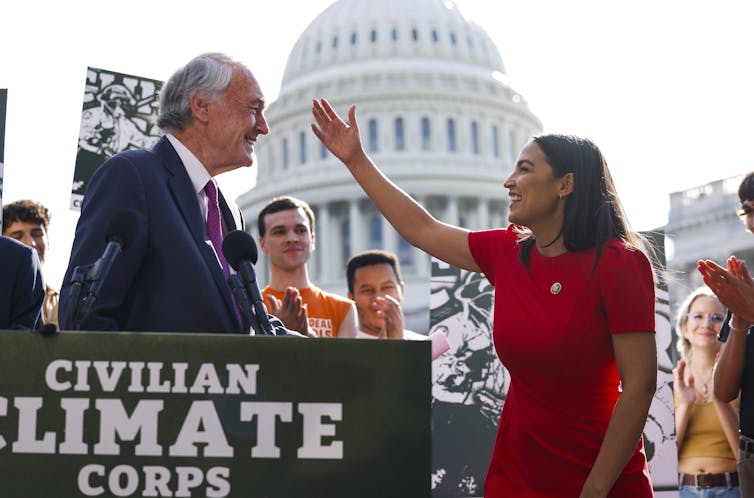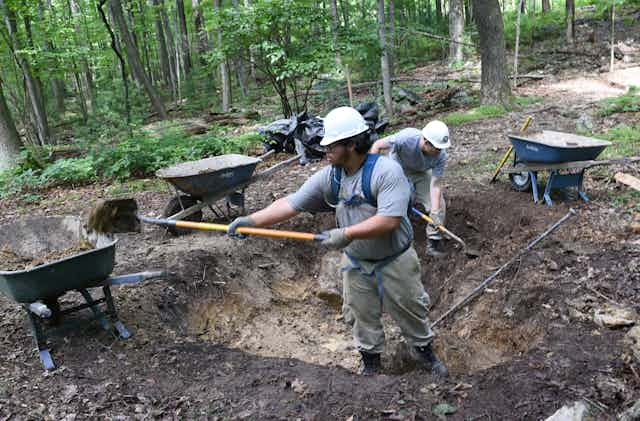When President Joe Biden created the American Climate Corps by executive order on Sept. 20, 2023, it marked a step toward keeping a pledge he made nearly three years earlier: to create a new workforce training and service program to deal with global warming.
The White House promises that the corps “will ensure more young people have access to the skills-based training necessary for good-paying careers in the clean energy and climate resilience economy.” By helping Americans get entry-level green jobs, such as solar panel installation and home insulation, it will equip thousands more young Americans to tackle the complex challenges posed by climate change.
As a scholar who researches and teaches about the history of U.S. volunteer service programs, I believe that the American Climate Corps will not provide anything radically new. Rather, it will largely offer the same experiences and work opportunities as an array of programs that already exist. But the Biden administration’s promise of connecting national service experience to long-term careers offers one important change to this model that I believe will make a difference to those who participate.
New Deal echoes
The inspiration for the American Climate Corps comes from President Franklin D. Roosevelt’s Civilian Conservation Corps. That New Deal program put unemployed – and mainly white – young men to work on public lands across the country to counter the devastating unemployment of the Great Depression.
Known as the CCC, it was a massive undertaking. Approximately 3 million men passed through its ranks over nine years. Those who served built much of the infrastructure of the country’s state and national parks, planted over 2 billion trees, fought forest fires and responded to natural disasters like floods.
The Biden administration aims to make its new corps far more inclusive in terms of gender, race and ethnic diversity. Rather than alleviating a short-term employment crisis, like its Depression-era predecessor, the American Climate Corps will emphasize launching careers.
So far it’s unclear how big this program will be. The White House has declined to specify a budget after repeatedly failing to persuade Congress to designate any funding for similar multibillion-dollar green jobs efforts because of Republican opposition.
Reportedly, the scaled-down American Climate Corps that Biden has bypassed Congress to establish could be funded through money appropriated to other parts of the government, such as the U.S. Agriculture Department, AmeriCorps and the National Oceanic and Atmospheric Administration.
The American Climate Corps, according to the details available, will mobilize far fewer participants than the CCC. The White House plans call for 20,000 people once it’s up and running, only 4% of the Civilian Conservation Corps’ peak enrollment of 500,000 men in 1935.

Network of similar programs already in place
This new service program is hardly the first to draw on the CCC’s example.
There are about 150 similar conservation service programs in the U.S., all connected through the National Association of Service and Conservation Corps. Known as the Corps Network, this patchwork includes 150 programs that give young adults and veterans opportunities to engage in service work on public lands and in rural and urban communities.
One of the oldest programs in what’s known as the Corps Network is the Student Conservation Association, founded in 1957. It puts thousands of high school and college-aged students to work on hiking trail improvement, tree planting and the restoration of natural acreage and waterways. Smaller programs like MobilizeGreen and New York City’s Green City Force focus on building a more inclusive green economy and training people for leadership skills or in tasks like building resilient urban food systems.
Many of these programs already get government funding through AmeriCorps, the federal agency for national service and volunteerism.
AmeriCorps also runs its own similar programs. The National Civilian Community Corps, established in 1993, deploys teams of young adults to projects that encompass energy conservation, infrastructure improvement, disaster recovery and response, and urban and rural development. Its website promises that “if you are 18-26, you can gain experience while supporting climate change mitigation.”
Operating since 1985, this amalgam of service programs already engages 20,000 young adults and veterans every year – the same number the Biden administration aims to mobilize. It’s unclear how the American Climate Corps might augment, replace or complement these programs. For instance, the corps’ focus on job training tied to solar, wind and other forms of renewable energy is relatively new – although some states have their own climate corps. Its emphasis on conserving land and water overlaps with the work existing state programs already do.
Scant objective evidence
There are different ways to assess whether service programs make a difference.
Many of them survey their participants, who regularly say they enjoyed the experience. Participants also cite a sense of personal growth, greater familiarity with environmental concerns and stronger leadership skills. One of the few studies conducted also found that people who took part in the conservation corps were more likely to pursue related careers.
These programs try to measure the impact of their work every year using metrics like hours served, miles of trails restored and acres of wetlands or forestry rehabilitated. But the data is largely self-reported and has never been rigorously or objectively collected and explored.
That means it’s hard to say whether funding these programs amount to an effective policy.
Better pay? Great opportunities?
Participants in the conservation corps programs that preceded Biden’s executive order get what amounts to small stipends and perhaps room and board. The low pay, which ranges from about US$16,000-$30,000 a year, can mean that they’re not an option for many recent college grads who might otherwise be interested.
Full-time AmeriCorps volunteers are also eligible to apply for grants to pay for their education or to make student loan payments on top of their earnings. These awards provide $6,895 in the 2023 fiscal year.
American Climate Corps backers argue it should pay a living wage as a form of “climate justice.”
It’s unclear whether the American Climate Corps will do that.
That’s why it’s important that the Biden administration is promising pathways to a high-paid career. It has outlined future cooperation between Americorps, the National Oceanic and Atmosphere Administration and the departments of Labor, Interior, Agriculture and Energy to help build links between American Climate Corps service and federal employment.
Answers to operational questions TBD
On top of the lack of clarity about its cost and funding and what participants will earn, it’s not clear to what extent the American Climate Corps will operate independently, or if it will support similar programs in the Corps Network.
For example, California, Michigan, Maine, Washington and Colorado already have their own climate corps. Five more states – Arizona, Utah, Minnesota, North Carolina and Maryland – unveiled their own when Biden signed the executive order for a national one.
Perhaps most importantly, it’s yet to be determined whether the American Climate Corps’ service work will differ from those state initiatives and similar programs. If not, this could simply be the rebranding of conservation programs as climate action.

